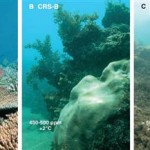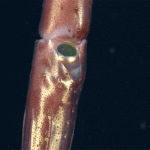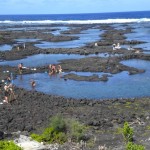Coral reefs are famous for their beautiful colours, but in fact when I visit them I am usually surprised how colourful reefs AREN’T. Most healthy corals have a sort of dusty tan or pink hue to them, and it’s only on reefs with particularly high coral cover, superb water clarity and bright overhead sun that you really see a lot of colours “pop”. The same cannot be said under UV light, however, as this video shot in the Gulf of Aqaba demonstrates spectacularly (more videos here). Many corals (and sometimes other reef organisms, as you’ll see) fluoresce under UV light, and that lends to the reef a surreal and psychedelic feel if you SCUBA at night and bring a blacklight with you. Fluorescence occurs when a material absorbs one wavelength of light and re-emits it at another wavelength. In this case the corals absorb the UV, which we can’t see, and they re-emit it in the visible wavelengths that we can, and so the corals appear to glow or emit their own light, because they are. The effect is quite stunning.
It seems that “native” fluorescence like this may not actually serve an adaptive function. Corals aren’t subjected to those UV wavelengths much in nature, so there’s no selective force to promote the evolution of this kind of trait. Instead, it’s more likely a wonderful and beautiful coincidence that can be exploited to make spectacular YouTube videos like this one! The culprits are different protein pigments in the corals and their symbiotic algae (Symbiodinium spp.) that serve important biological functions for the coral, acting as electron donors in biochemical reactions, as anti-oxidants and other functions. But, they also just happen to fluoresce under the right wavelengths of illumination. This class of proteins includes the famous GFP, Green Fluorescent Protein, first isolated from jellyfish but these days genetically engineered into a whale range of organisms as a molecular biological tool.
Video link via @DrBondar on Twitter. More about Carin here.






“whale range.” Unintentional perhaps. But if so, I believe you’ve just inadvertently coined a new idiom. I like it. Consider the #whalerange born on Nov 30.
Ha! Nice pick up. I think I’m going to leave that one right as it is!
“Poor Man’s Fluorodiving”: Lighting your tank with blue actinics while wearing yellow hunting glasses.
Love the orange Scorpaeniform in there! Didn’t get a close enough look to see which it was, but most of them glow orange or pink… making them MUCH easier to spot at night with UV. That’s how I find them in tide pools for my research :)
I didn’t know that – there’s my TIL for the day. I was surprised how much it fluoresced compared to the other fish, which were pretty tame (except the tail on that pipefish). Do you use NightSea equipment for yours? They have some insane pics on their website. Look at this ridonkulous moray http://www.nightsea.com/wp-content/uploads/2012/07/sport-AlexTyrrell_Dumaguete-02.jpg
This video is awesome. The flourescence is so stinking awesome. Did you see the hermit crab with the glowing shell? What was causing the flourescence there?
Well, the shells of crustaceans are also full of protein pigments like crustacyanin, which joins with astaxanthin and other carotenoid (non protein) pigments to confer many of the shells colours. My guess is that they fluoresce under UV too. I wrote a bit about that for my old blog here: http://bit.ly/pF7eII
The amazing beauty of nature
What about sea anemones? Some hermit crabs are symbiotic with sea anemones in the genus Calliactis. That was my first impression when I saw the hermit crab.
Contrary to what the article above appears to suggest, this video was not made using ultraviolet light (“blacklight”), but with blue light.
The principle is the same, but one needs additional filters to make the blue light invisible to the camera and eyes, in order to be able to see only the fluorescence.
The reason is that blue emitters are more efficient and less expensive than ultraviolet ones, but most importantly, the fluorescence effect is stronger with blue light.
The reason for the latter is probably because the underwater organisms have evolved to adapt to the properties of water, which is more transparent to blue light than it is to ultraviolet.
The torches used all have between about 60 W and 80 W of electrical power. One was bought from the German manufacturer Hartenberger, the other two are own developments (see http://picasaweb.google.com/ostbey/HowToBuildYourOwnUltravioletDivingLamp5 and http://picasaweb.google.com/ostbey/HowToBuildYourOwnUltravioletDivingLamp6).
They cost about 1000 Euros each, including the necessary rechargeable battery.
However, for simply observing fluorescence, not necessarily for filming and photographing, much less expensive torches are sufficient.
Some can be found on our website, http://www.firedivegear.com.
Thanks for the clarification Steffen. I’m glad the blue light is cheaper and more efficient
For those interested in trying it, here’s another gear vendor http://www.nightsea.com/area-of-use/sport-diving/
I wonder if these proteins could be used in the tattoo trade, as a safer alternative to the UV inks currently in use.